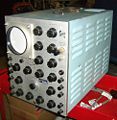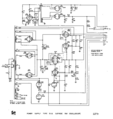511: Difference between revisions
No edit summary |
No edit summary |
||
| Line 1: | Line 1: | ||
The 511 was Tek's first product, [[introduced in 1947|introduced in June 1947]]. | {{Oscilloscope Sidebar | | ||
A revised version, the 511A, was [[introduced in 1950]]. | title=Tektronix 511| | ||
Charles Vollum was directly involved with the design of the 511. | summary=10 MHz Tube scope<br />''First Tektronix product''| | ||
It uses a standard CRT, the [[5CP1A]]. | image=Tek 514d front.jpg | | ||
The vertical output of the 511A is a pair of [[6AG7]] tubes, | caption=Tektronix 514 front | | ||
years=1947 - 1953 | | |||
manuals=.* [http://w140.com/tek_511.pdf Tektronix 511 Manual (PDF)] | |||
* [http://bama.edebris.com/download/tek/511aearly/Tek%20511A%20Pre%20SN2869.pdf Tektronix 511A Manual pre SN 2869 (PDF)] | |||
* [http://bama.edebris.com/download/tek/511alater/Tek%20511A%20SN%202869-5099.pdf Tektronix 511A Manual SN 2869-5099 (PDF)] | |||
* [http://richardsears.wordpress.com/2012/01/07/near-the-beginning-of-an-era-the-tektronix-511a/ Richard Sears' 511A Page] | |||
* [http://w140.com/1947+Tektronix_Catalog.pdf Tektronix 1947 Catalog with 511 (PDF)] | |||
}} | |||
The 511 was '''Tek's first product''', [[introduced in 1947|introduced in June 1947]]. | |||
A revised version, the 511A, was [[introduced in 1950]]. [[Charles Vollum]] was directly involved with the design of the 511. | |||
It uses a standard CRT, the [[5CP1A]]. The vertical output of the 511A is a pair of [[6AG7]] tubes, | |||
AC-coupled to the vertical deflection plates. | AC-coupled to the vertical deflection plates. | ||
The 511A does not have response down to DC. The frequency range is specified as 10 Hz to 10 MHz. | |||
There is also a 511AD. The "D" in the model number indicates that it has a L-C [[delay line]]. | |||
The 511 weighs 65 pounds (29 kg) and consumes 180 W. The 511A weighs 50 pounds (23 kg) and consumes 230 W. | |||
The 511 was produced with serial numbers 101 to 454. | Neither the 511 nor the 511A has a [[thermal cutoff]]. The 511AD was available through 1953. | ||
The 511A has serial numbers 455 and up. | |||
The 511 was produced with serial numbers 101 to 454. The 511A has serial numbers 455 and up. | |||
The main difference between the 511 and the 511A is the power supply. | The main difference between the 511 and the 511A is the power supply. | ||
In the 511 there are two power transformers, | In the 511 there are two power transformers, | ||
T1 and T2, both operating on | T1 and T2, both operating on 60 Hz mains power with their primaries in series. | ||
T1 produces the CRT anode and cathode voltages, as well as various other | T1 produces the CRT anode and cathode voltages, as well as various other | ||
regulated and unregulated voltages. The CRT cathode and anode voltages in | regulated and unregulated voltages. The CRT cathode and anode voltages in | ||
| Line 25: | Line 33: | ||
of regulation means that variations in mains voltage results in variation | of regulation means that variations in mains voltage results in variation | ||
of deflection sensitivity. | of deflection sensitivity. | ||
In the 511A, the CRT cathode and anode voltages are produced by an | In the 511A, the CRT cathode and anode voltages are produced by an 2 kHz oscillator | ||
that is powered by the 511A's + | that is powered by the 511A's +225 V<sub>DC</sub> regulated supply. This results in vertical | ||
deflection calibration that is independent of mains voltage. | deflection calibration that is independent of mains voltage. | ||
The 511 and 511A use a [[6AL5]] tube (V3) as the disconnect diode for the sweep. | The 511 and 511A use a [[6AL5]] tube (V3) as the disconnect diode for the sweep. | ||
Tektronix engineer Frank Hood recollects: | Tektronix engineer Frank Hood recollects: | ||
<blockquote> | <blockquote>My first assignment was to build or modify some special instruments for Bonneville Power. They wanted a device that would detect and record any lightning strikes or arc-overs on the high voltage power lines running between Vancouver, Wash. and other cities such as Longview, Spokane, etc. They wanted to detect each event, in a fraction of a millionth of a second, then to send a pulse of energy down the defective line and measure the time it took to return, (this was an application much like radar). They wanted markers displayed at each mile and fraction of a mile so that they could determine the exact location of the fault. They needed to record a photographic image for latter study. Two or more such instruments were built. We called these Type 511B. They worked very well and were used for several years. | ||
</blockquote> | </blockquote> | ||
The 511 and 511A were normally furnished with P1 [[phosphor]]. | The 511 and 511A were normally furnished with P1 [[phosphor]]. P7 and P11 were optional, at no extra charge. | ||
P7 and P11 were optional, at no extra charge. | |||
There was an option that added a | There was an option that added a 1 μs marker generator. | ||
==Specifications== | |||
==Pictures== | |||
<gallery> | <gallery> | ||
Image:Tek 511a 1.JPG | Image:Tek 511a 1.JPG | ||
| Line 58: | Line 61: | ||
Image:511a sweep.png | Image:511a sweep.png | ||
</gallery> | </gallery> | ||
[[Category:500 series scopes]] | |||
Revision as of 05:40, 19 May 2014
The 511 was Tek's first product, introduced in June 1947. A revised version, the 511A, was introduced in 1950. Charles Vollum was directly involved with the design of the 511.
It uses a standard CRT, the 5CP1A. The vertical output of the 511A is a pair of 6AG7 tubes, AC-coupled to the vertical deflection plates.
The 511A does not have response down to DC. The frequency range is specified as 10 Hz to 10 MHz. There is also a 511AD. The "D" in the model number indicates that it has a L-C delay line. The 511 weighs 65 pounds (29 kg) and consumes 180 W. The 511A weighs 50 pounds (23 kg) and consumes 230 W.
Neither the 511 nor the 511A has a thermal cutoff. The 511AD was available through 1953.
The 511 was produced with serial numbers 101 to 454. The 511A has serial numbers 455 and up. The main difference between the 511 and the 511A is the power supply. In the 511 there are two power transformers, T1 and T2, both operating on 60 Hz mains power with their primaries in series. T1 produces the CRT anode and cathode voltages, as well as various other regulated and unregulated voltages. The CRT cathode and anode voltages in the 511 are simply rectified voltages from the secondary of T1. The lack of regulation means that variations in mains voltage results in variation of deflection sensitivity. In the 511A, the CRT cathode and anode voltages are produced by an 2 kHz oscillator that is powered by the 511A's +225 VDC regulated supply. This results in vertical deflection calibration that is independent of mains voltage.
The 511 and 511A use a 6AL5 tube (V3) as the disconnect diode for the sweep.
Tektronix engineer Frank Hood recollects:
My first assignment was to build or modify some special instruments for Bonneville Power. They wanted a device that would detect and record any lightning strikes or arc-overs on the high voltage power lines running between Vancouver, Wash. and other cities such as Longview, Spokane, etc. They wanted to detect each event, in a fraction of a millionth of a second, then to send a pulse of energy down the defective line and measure the time it took to return, (this was an application much like radar). They wanted markers displayed at each mile and fraction of a mile so that they could determine the exact location of the fault. They needed to record a photographic image for latter study. Two or more such instruments were built. We called these Type 511B. They worked very well and were used for several years.
The 511 and 511A were normally furnished with P1 phosphor. P7 and P11 were optional, at no extra charge.
There was an option that added a 1 μs marker generator.









